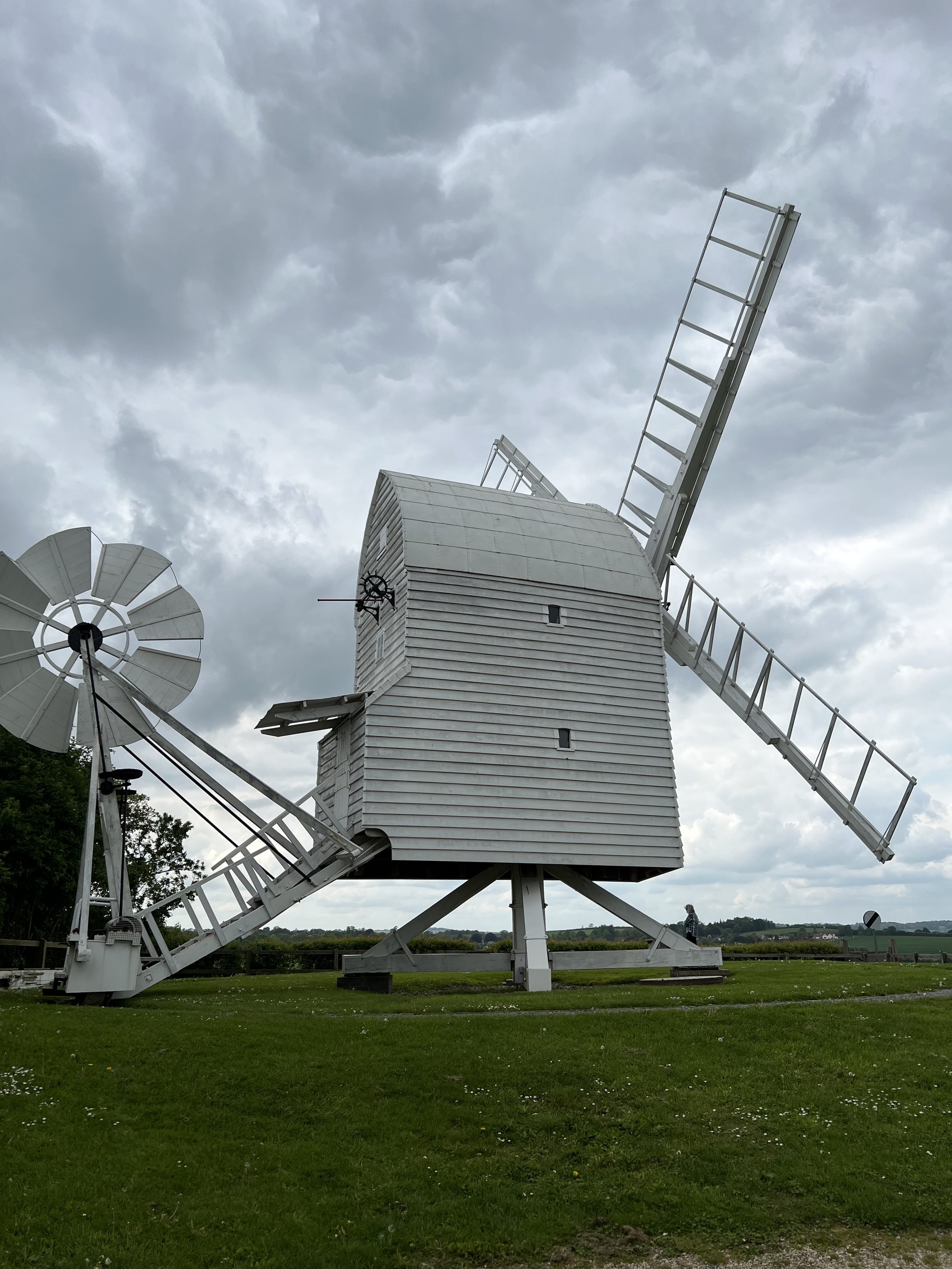When I visited Great Chishill Windmill in mid-May, cyclists, motorists and walkers were stopping to take pictures of the white weather-boarded mill on its green knoll overlooking the south Cambridgeshire countryside. Larks were singing, scudding clouds dotted the sky. Easy to imagine a time when every upland village had a mill and slowly turning sails would have been visible across the skyline.
There has been a windmill here since at least the 1500s, but the present structure dates from 1819. It has a nautical feel, and this must have been even more striking when canvas covered the four huge sails. The timbers which form the open post and trestle are rough and massive, much like the timbers of a sailing ship, and indeed some of the smaller beams inside the housing (the ‘buck’) were repurposed from shipwrecks, such wood being too valuable to discount even this far inland.
On alternate Sundays in the summer months, the windmill is open to visitors. A rustic outdoor staircase takes you to the cramped and shadowy meal floor, where a collection of ancient mostly wooden tools was abandoned in 1951 when the last owners locked up and walked away. The primitive but highly effective machinery is still in place, complete with wind shaft, clutch lever and chain sack hoist. The air smells as it must have done for centuries, of dust and grease and timber. And flour too, though plans to return Great Chishill to a working mill are yet to be fulfilled.
Most of the mill is built of un-planed oak, not least because metal would have increased the risk of fire from stray sparks. The ‘crown tree’ or beam on which the weight of the entire structure rests is a vast single oak which must have been centuries old when it was felled. The hammers and wedges used to lever apart the millstones for dressing were made of wood, the meal spout is wooden, most of the moving parts are made of oak or applewood.
The planking underfoot is uneven, the walls too. The mill must have been draughty even on warm days and freezing in winter. Gaps in the mechanism are plugged with knots of hessian, much as oakum was used to caulk ships in the age of sail. Hinges are simple and made of leather, iron nails are used instead of screws. There is a practical, makeshift air about the place. It is rough and ready, a prototype factory. The popular stereotype of the fat miller could not be further from the reality. The mechanism was constantly shaken loose and had to be hammered back into line using tools almost too heavy to lift. The miller would have toiled from dawn to dusk, though the fantail added in 1892 was a technological leap which enabled him to set up the mechanism without further adjustment even if the wind speed increased - a great improvement on days gone by.
From the meal floor you climb a near-vertical ladder to the even smaller stone floor with its cross beams and sets of huge stones. Here you learn about the simple but ingenious engineering which enabled generations of millers to harvest the wind in exactly the right way to grind wheat at optimal speed. The wind was also harnessed to hoist the sacks to the top floor, while sets of governors prevented the sails from moving the mechanisms too fast.
I am in the middle of writing a novel set in the English West Indies in 1704. The islands of Barbados and Antigua were dotted with stone windmills at that time, and when I visited Great Chishill I immediately thought of my story. The site is beautiful now, but when the mill was operational the plot on which it stands would have been messy and industrialised. The life of the miller and his boy would have been unrelentingly hard, perhaps in some respects as hard as that of the slaves who worked the sugar mills in the Caribbean. They depended for nails and other metal parts on the village blacksmith, but the forge was at the far end of the village where prevailing winds could carry off the smoke into the fields. When my tour guide Nigel Parslow described this, I pictured Great Chishill not quiet and green as it is today, but full of activity and noise. The rural economy then was based on hard physical graft and on a web of relationships between different occupations: miller and millwright, blacksmith and farmer.
The distinction between countryside and town is much clearer now than when agriculture co-existed with industry. Until the mid-twentieth century, woods would have rung with the sounds of axes and saws, and the air would have been thick with scents of sap and burning charcoal. Boatyards would have lined many riverbanks; lanes that are now peaceful would have been choked with waggons and with overladen hay wains. In my own village the green was once the site of both light and heavy industry: a substantial bakery stood there, and so did the forge and the wheelwright’s workshop. And for hundreds of years on the hill at Great Chishill the mill must have creaked in the gale like a three-masted ship, its trapdoors banging as an endless chain of grain sacks passed through them to the top, the huge stones scraping and rumbling all day long as the sails turned and flumped in the wind.









